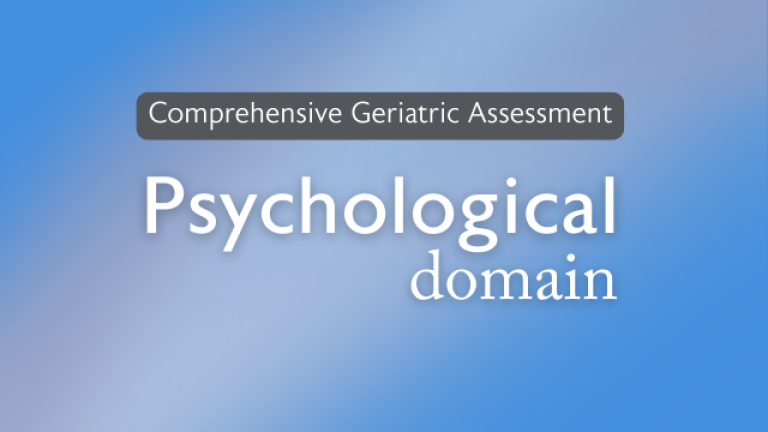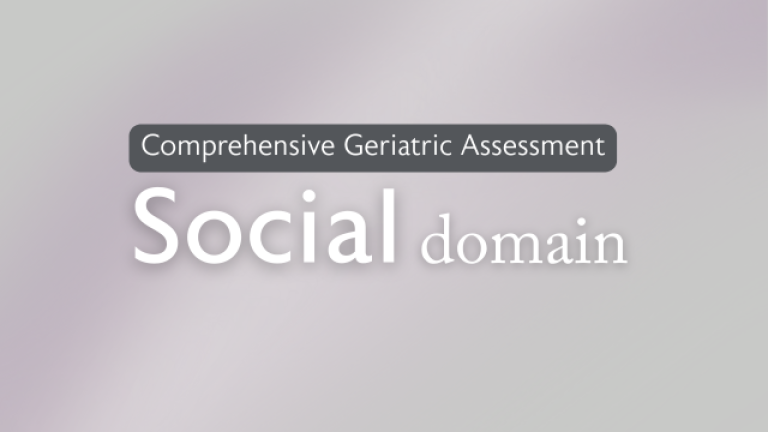Comprehensive Geriatric Assessment (CGA): Environmental domain
The living environment is an essential element of CGA as it directly impacts an older adult’s safety, independence, and quality of life.
A well-suited environment can support autonomy and reduce health risks, whereas an unsuitable or hazardous environment can contribute to functional decline, social isolation, and increased use of health and care resources. Evaluating the living environment allows healthcare professionals to recommend modifications that enhance accessibility, safety, and comfort.
Frailty increases vulnerability to environmental challenges. Individuals with frailty often have reduced mobility, impaired balance, cognitive decline, and sensory deficits, which heighten their risk of falls, accidents, and difficulty performing daily activities. Poor living conditions - such as inadequate lighting, clutter, lack of assistive devices, or inaccessible home layouts - can accelerate dependency and increase the likelihood (and frequency) of hospitalisation or institutionalisation. Research highlights that home modifications, including grab bars, stair lifts, and smart home technology, significantly improve safety and prolong independent living. An assessment of the social environment at home helps to reduce risk of loneliness.
Key aspects of the living environment assessment include:
- Physical accessibility: presence of stairs, narrow hallways, thresholds.
- Home layout and functionality: suitability and location of bedroom, bathroom, kitchen.
- Lighting and visibility: adequate lighting in key areas to prevent falls, to support accessing the toilet at night.
- Temperature control and ventilation: risks of hypothermia or heat-related illness.
- Clutter and trip hazards: rugs, furniture placement, cords, and general tidiness.
- Social and emotional environment: availability of social support, risk of isolation.
- Technology and emergency response systems: access to call (pendant) alarms, phones, or medical alert systems.
Adaptions to living environments may be impacted by access to social support and financial circumstances, and people may not be aware of what help is available to them, so it is vital to include these aspects in discussions.
Home safety
Home safety assessment is essential in CGA as it helps identify risks that can lead to falls, injuries, or other preventable incidents. Ensuring a safe home environment supports independence, reduces emergency hospital visits, and enhances overall well-being for the older person. Addressing safety concerns early can help older adults maintain their ability to live at home for longer.
Frailty increases the risk of falls, fractures, head injury, burns, and other home-related accidents. This can be due to multiple reasons, such as reduced strength, slower reaction times, cognitive impairment, and side effects of medicines. Evidence suggests that home safety modifications (such as grab rails) can reduce fall rates and subsequent hospital admissions or in some instances (e.g. pendant alarms) can also help get the right intervention to a person sooner. Perception of poor home safety can lead to anxiety about falling, which in turn can reduce activity levels, leading to further deconditioning and physical decline. Individuals with frailty may also struggle with emergency response if they experience an accident, making proactive safety assessments critical.
Key home safety elements to evaluate include:
- Fall prevention: presence of grab bars, non-slip mats, stair rails, and appropriate footwear.
- Fire and electrical safety: functioning smoke alarms, accessible fire extinguishers, safe wiring, and appliance maintenance.
- Medication safety: proper medication storage, clear labelling, regular review and adherence to prescriptions.
- Emergency preparedness: easy access to a phone, emergency contacts, and medical alert systems.
- Cognitive-related safety risks: risks associated with kitchen tasks, gas/oven use, wandering or memory loss in individuals with dementia.
- Safe mobility aids: mobility aids which have been properly fitted for the individual including walkers, canes and wheelchairs.
As with discussion of living environments, ability to implement home safety measures may be impacted by access to social support and financial circumstances, and people may not be aware of what help is available to them, so it is vital to include these in CGA conversations.
References
References
Click to expand
- Jiang, YS., Shi, H., Kang, YT. et al. Impact of age-friendly living environment and intrinsic capacity on functional ability in older adults: a cross-sectional study. BMC Geriatr 23, 374 (2023). https://doi.org/10.1186/s12877-023-04089-5
- Sriram, V., Jenkinson, C. & Peters, M. Carers using assistive technology in dementia care at home: a mixed methods study. BMC Geriatr 22, 490 (2022). https://doi.org/10.1186/s12877-022-03167-4
- Sriram, V., Jenkinson, C. & Peters, M. Informal carers’ experience of assistive technology use in dementia care at home: a systematic review. BMC Geriatr 19, 160 (2019). https://doi.org/10.1186/s12877-019-1169-0
- Machiko R. Tomita, Sumandeep Saharan, Sheela Rajendran, Susan M. Nochajski, Jo A. Schweitzer; Psychometrics of the Home Safety Self-Assessment Tool (HSSAT) to Prevent Falls in Community-Dwelling Older Adults. Am J Occup Ther November/December 2014, Vol. 68(6), 711–718. doi: https://doi.org/10.5014/ajot.2014.01080
- Pega F, Kvizhinadze G, Blakely T, et alHome safety assessment and modification to reduce injurious falls in community-dwelling older adults: cost-utility and equity analysisInjury Prevention 2016;22:420-426.





